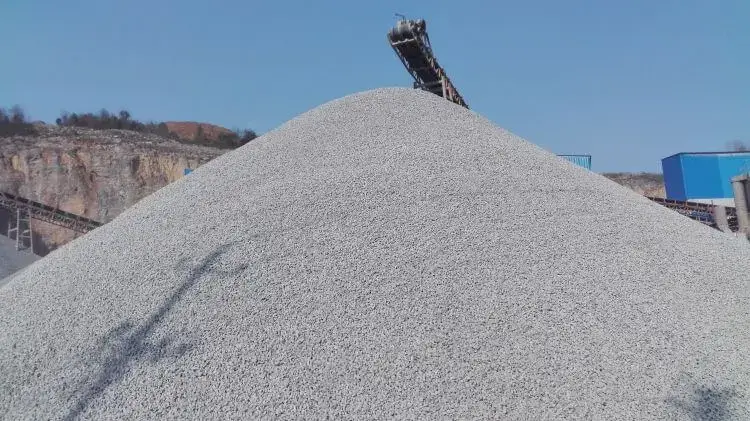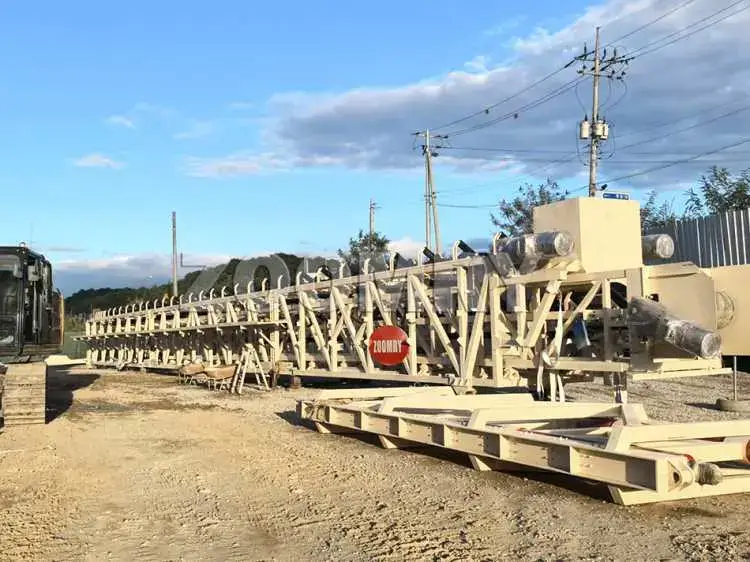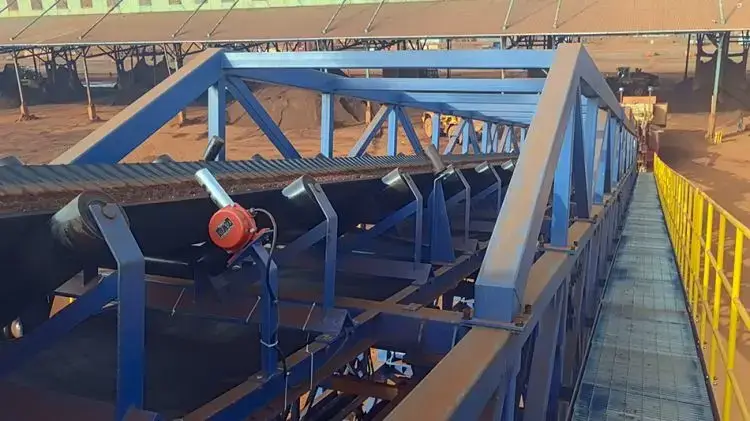Time:2025-10-13 16:57:07 Number of Clicks:
As a professional bulk material conveying equipment manufacturer and EPC general contractor, ZOOMRY has long focused on the bulk material handling field. It mainly specializes in core equipment such as belt conveyors, ZR-SF Series Radial Telescopic Stackers, ZRSL Series Mobile Ship Loaders, as well as high-precision components like idlers and rollers. Its products are widely used in industries such as mining, cement, and thermal power. In recent years, with the advancement of global low-carbon policies and the expansion of enterprise production capacity, many limestone processing enterprises are facing the pain points of traditional mobile stackers, including "stacking capacity lagging behind the needs of production lines, short service life of traveling wheels, and high power consumption per ton of products". Some enterprises even have to reduce the capacity of upstream crushers to match the efficiency of stackers, which seriously affects production efficiency.

In the limestone processing scenario, the problems of traditional mobile stackers are concentrated in three aspects, which have become key bottlenecks restricting the production capacity and efficiency of enterprises:
ZOOMRY's transformation solution follows the principle of "based on the customer's existing equipment, minimizing transformation costs while maximizing efficiency improvement". The core idea is: on the premise of keeping the belt width of the belt conveyor unchanged, break through the bottleneck of conveying capacity by increasing the belt speed, and simultaneously strengthen the stacker body structure, upgrade the drive and control system, and optimize core components to ensure that the equipment performance meets international standards and long-term operation needs.
The transformation covers three modules: "feed belt conveyor - mobile stacker body - auxiliary system", focusing on solving the problems of "conveying efficiency, structural strength, energy consumption and environmental protection". The specific technical route is in line with ZOOMRY's product concept of "Building High-Quality Conveying Equipment, Forging a Century-Old Foundation", and at the same time integrates intelligent control technology to adapt to the future digital production needs of enterprises.

The conveying system is the core for improving stacking capacity. The transformation focuses on the two feed belt conveyors and the mobile stacker body. Through belt speed upgrade and drive optimization, the overall conveying capacity is increased from 1800 t/h to more than 2400 t/h (calculation formula: Q = krvc§, where k = 800 (end face coefficient), r = 1.4 t/m³ (limestone bulk density), v = 2.85 m/s (upgraded belt speed), c = 0.85 (inclination coefficient), § = 0.9 (speed coefficient), and the calculated conveying capacity reaches 2441.88 t/h).
For the original feed belt conveyor (belt width: 1.4 m) with a belt speed of 2.0-2.5 m/s, it is upgraded to a design with adjustable speed of 2.85 m/s. Among them, the low-load feed belt conveyor (original motor: 37 kW) adopts the idle stacker drive system of ZOOMRY (90 kW YE4 first-class energy efficiency motor, drive roller diameter: 1000 mm). The traditional hydraulic coupling is eliminated, and a high-strength coupling is used for connection instead. At the same time, the drive base is redesigned (using Q355B carbon steel to ensure load-bearing stability); for the high-load feed belt conveyor (original 2×132 kW motors), the original motors are retained (the power meets the requirements after calculation), and 2 sets of ZOOMRY customized reducers (adapting to SEW/FLENDER gear motors with a transmission efficiency of over 96%) and 2 sets of frequency converters are added to realize frequency conversion speed regulation and reduce the impact load during start-up and shutdown.
The traditional cantilever belt conveyor is replaced with the core conveying module of ZOOMRY's ZR-SF Series Radial Telescopic Stackers, with the belt speed increased to 2.85 m/s (adjustable), and equipped with a 110 kW YE4 energy-saving motor (complying with IE4 energy efficiency standards) and a frequency converter. At the same time, the rigidity and strength of the stacker cantilever are checked, and the lattice frame structure is used for reinforcement (the strength-to-weight ratio is increased by 30%). Customized counterweights are made according to the on-site counterweight requirements to ensure the stable operation of the cantilever within the inclination range of -14° to +17°.
The performance of core components directly determines the equipment service life and environmental protection level. The transformation adopts high-precision components independently produced by ZOOMRY to improve equipment reliability from two aspects: wear control and dust management. In terms of idler and roller upgrade, the original idlers are replaced with ZOOMRY's low-noise idlers, which have a radial runout of ≤0.4 mm (when length < 550 mm), axial displacement of < 0.4 mm, rotational resistance of ≤2 N (lower than the 3 N requirement of GB standard), operating noise of < 45 dB, and service life of more than 50,000 hours; the drive rollers are made of 40Cr material, processed by a CNC four-roll rounding machine (ellipticity < 1.5 mm), and undergo ultrasonic flaw detection and stress relief treatment after welding to ensure that the load-bearing capacity and wear resistance meet the requirements of high-load operation.
To extend the service life of the belt of the conveying module and control dust emission, a ZOOMRY customized buffer bed (using polymer wear-resistant materials, specially designed for the stress characteristics of the conveying module) is added at the material receiving end of the module to avoid belt damage caused by high-speed impact of materials; 1 set of polyurethane (PU) cleaning device and 2 sets of alloy cleaners are installed at the empty section of the module belt, with a cleaning efficiency of over 95%, reducing dust generation during belt operation; at the same time, according to customer needs, ZOOMRY's non-powered dust removal chute (accurately connected to the discharge port of the conveying module) can be optionally equipped to further control dust diffusion during material transfer, ensuring that the dust emission concentration at the factory boundary is reduced to below 10 mg/m³.
The traveling and lifting system is the foundation for the stable operation of the mobile stacker. The transformation focuses on optimizing the wheel pressure distribution, drive power and safety protection design to completely solve the problems of deviation, rail gnawing and short service life of traditional equipment. In terms of the upgrade of the traveling system, 4 sets of driven wheel groups are added to the original traveling mechanism, and ZOOMRY's articulated trolley structure is adopted (the trolley is hinged with the main machine to adapt to complex site terrain). The wheel specifications and the tail car wheels are uniformly changed to a double-wheel design (replacing the traditional single wheel), reducing the wheel pressure by 40%. At the same time, oil injection nozzles are reserved for daily maintenance and lubrication; the traveling drive power is increased to 4×11 kW, adopting an external brake (easy for inspection and maintenance) and a frequency conversion drive system. A frequency converter feedback unit is added to realize braking energy recovery (recovery efficiency up to 20%), and the PLC control system is used to accurately adjust the traveling speed and direction to avoid deviation and rail gnawing.
In terms of the hydraulic lifting system, it is fully replaced with a ZOOMRY customized solution: the drive end is equipped with a ≥15 kW first-class energy efficiency motor, matched with an imported plunger pump (with a dual-adjustment mechanism for pressure and flow, which can dynamically adjust the output according to the load of the conveying module to avoid energy waste); the hydraulic cylinder specification is customized to 250 mm/160 mm (cylinder diameter/rod diameter), and the stroke accurately matches the lifting requirement of the conveying module (about 1600 mm). The pipeline adopts high-pressure seamless steel pipes with a pressure-bearing grade of 60 MPa to ensure no leakage risk under high load; the cylinder connection parts all use 12.9-grade high-strength bolts (tensile strength ≥1200 MPa), and the seals adopt imported combined seal structures (wear-resistant, anti-aging, with a leak-proof service life of more than 8000 hours, far higher than the industry average standard of 5000 hours).
To ensure maintenance safety, a maintenance support rod for the telescopic conveying arm is specially designed (adapting to the ZR-SF series module structure, which can quickly lock the position of the conveying arm) to avoid accidental settlement of the module when the hydraulic system releases pressure; at the same time, the hydraulic control logic is optimized, and the PLC is used to accurately control the stress state of the oil cylinder to ensure that the hydraulic cylinder is always in a tension state (rather than compression) when the telescopic conveying arm is in the horizontal and upward tilting working conditions, fundamentally avoiding the occurrence of "cylinder pulling" faults in the traditional design and extending the overall service life of the hydraulic system.
To improve the equipment operation and maintenance efficiency and operation safety, the transformation integrates ZOOMRY's PLC+HMI intelligent control system. The system complies with the International Electrotechnical Commission (IEC) standards and has strong anti-interference capability (adapting to harsh industrial environments such as dust and vibration). The control system supports three operation modes: full automatic, remote control and manual. The programmable PLC controller is used to realize the automation of the stacking process, such as automatically adjusting the telescopic length and luffing angle, reducing the cost of manual intervention; the 10-inch high-definition HMI touch screen can display real-time equipment operation parameters (belt speed, current, oil pressure, temperature, etc.), facilitating operators to monitor the equipment status.
The system also adds a fault early warning function. For common problems such as belt deviation, excessive bearing temperature and abnormal hydraulic pressure, it promptly reminds operation and maintenance personnel through sound and light alarms and remote notifications (supporting connection to the enterprise MES system), shortening the fault response time; at the same time, it reserves function expansion interfaces, which can be connected to AI visual inspection systems, equipment health management platforms, etc. in the later stage to help enterprises realize digital transformation.

After the transformation, the performance and efficiency of the limestone mobile stacker have been improved in multiple dimensions, fully meeting the limestone supply needs of the enterprise's multiple clinker production lines, and complying with global low-carbon and environmental protection requirements:
As a professional service provider in the global bulk material conveying equipment field, ZOOMRY has always taken "helping customers reduce production costs, improve production capacity and reduce environmental impact" as its goal. This limestone mobile stacker capacity improvement and transformation solution relies on the company's more than 20 years of EPC project experience, independent core component production capacity (idlers, rollers, etc.) and internationally certified technologies, which not only solves the current production capacity bottleneck of enterprises, but also lays a foundation for long-term low-carbon operation.
From scheme design, component production to on-site installation and commissioning, ZOOMRY provides full-process services, and can customize subsequent operation and maintenance schemes (such as spare parts supply, equipment overhaul, upgrade and transformation) according to customer needs to ensure the continuous and stable operation of equipment. In the future, the company will continue to focus on technological innovation in bulk material handling and provide more efficient, energy-saving and environmentally friendly conveying solutions for global customers.
Copyright © 2002-2024 Zoomry Group Company Limited